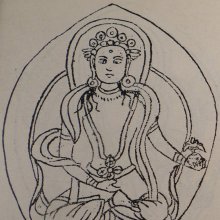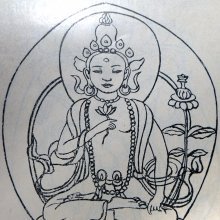Amritaprabha, Amṛtaprabha: 8 definitions
Introduction:
Amritaprabha means something in Buddhism, Pali, Hinduism, Sanskrit, Jainism, Prakrit. If you want to know the exact meaning, history, etymology or English translation of this term then check out the descriptions on this page. Add your comment or reference to a book if you want to contribute to this summary article.
The Sanskrit term Amṛtaprabha can be transliterated into English as Amrtaprabha or Amritaprabha, using the IAST transliteration scheme (?).
Images (photo gallery)
In Hinduism
Purana and Itihasa (epic history)
Source: Cologne Digital Sanskrit Dictionaries: The Purana IndexAmṛtaprabha (अमृतप्रभ).—Gods of Sāvarṇi epoch.*
- * Bhāgavata-purāṇa VIII. 13. 12.

The Purana (पुराण, purāṇas) refers to Sanskrit literature preserving ancient India’s vast cultural history, including historical legends, religious ceremonies, various arts and sciences. The eighteen mahapuranas total over 400,000 shlokas (metrical couplets) and date to at least several centuries BCE.
Kavya (poetry)
Source: Wisdom Library: Kathāsaritsāgara1) Amṛtaprabhā (अमृतप्रभा), daughter of Parvata, is one of the twelve female friends of Mahallikā: daughter of Prahlāda, according to the Kathāsaritsāgara, chapter 45. Accordingly, as Mahallikā said to Sūryaprabha: “... my female friends are not only two, but twelve in number, and my father’s brother carried them off from Indra’s heaven. The first is named Amṛtaprabhā, the second Keśinī; these are the auspiciously marked daughters of the hermit Parvata... They [eg., Amṛtaprabhā] are all heavenly nymphs, born from Apsarases, and when I was married they were taken to the first underworld, and I must bestow them on you, in order that I may be always with them”.
2) Amṛtaprabhā (अमृतप्रभा) is the name of a Vidyādhara, as mentioned in the Kathāsaritsāgara, chapter 107. Accordingly, as Amṛtaprabha said to prince Naravāhanadatta: “... I, Prince, am a king of the Vidyādharas named Amṛtaprabha, and I have been sent by Śiva on the present occasion to save your life. Here is the mountain of Kailāsa in front of you, the dwelling-place of that god; if you propitiate Śiva there, you will obtain unimpeded felicity. So, come, I will take you there”.
The Kathāsaritsāgara (‘ocean of streams of story’), mentioning Amṛtaprabhā, is a famous Sanskrit epic story revolving around prince Naravāhanadatta and his quest to become the emperor of the vidyādharas (celestial beings). The work is said to have been an adaptation of Guṇāḍhya’s Bṛhatkathā consisting of 100,000 verses, which in turn is part of a larger work containing 700,000 verses.

Kavya (काव्य, kavya) refers to Sanskrit poetry, a popular ancient Indian tradition of literature. There have been many Sanskrit poets over the ages, hailing from ancient India and beyond. This topic includes mahakavya, or ‘epic poetry’ and natya, or ‘dramatic poetry’.
In Buddhism
Tibetan Buddhism (Vajrayana or tantric Buddhism)
Source: archive.org: The Indian Buddhist Iconography1) Amṛtaprabha (अमृतप्रभ) (“light of nectar”) is another name for Amitaprabha: a Bodhisattva commonly depicted in Buddhist Iconography, and mentioned in the 11th-century Niṣpannayogāvalī of Mahāpaṇḍita Abhayākara.
Amṛtaprabha is described in the Niṣpannayogāvalī (Durgatipariśodhana-maṇḍala) as follows:—
“Amṛtaprabha is white in colour. In his right hand he holds the jar of nectar on the crown of his head. His clenched left hand rests on the hip”.
2) Amṛtaprabha (अमृतप्रभ) or Amṛtaprabhalokeśvara refers to number 41 of the 108 forms of Avalokiteśvara found in the Machhandar Vahal (Kathmanu, Nepal). [Machhandar or Machandar is another name for for Matsyendra.].
Accordingly,—
“Amṛtaprabha also is one-faced and two-armed and sits in the Vajraparyaṅka attitude on a lotus. He holds the double Vajra on his lap with his right hand, and the lotus on a water-vessel in his left”.
The names of the 108 deities [viz., Amṛtaprabha] possbily originate from a Tantra included in the Kagyur which is named “the 108 names of Avalokiteshvara”, however it is not yet certain that this is the source for the Nepali descriptions.Source: Brill: Śaivism and the Tantric Traditions (tantric Buddhism)
Amṛtaprabha (अमृतप्रभ) refers to one of the sixteen Bhadrakalpa Bodhisattvas, according to the Niṣpannayogāvalī 44ff and Abhayākaragupta’s Durgatipariśodhana-maṇḍala (Cf. Niṣpannayogāvalī 66ff.).—A set of sixteen Bodhisattvas often supplements the deities of the Tattvasaṃgraha in later Vajradhātu-maṇḍala descriptions. These are generally the sixteen Bodhisattvas of the present aeon (bhadrakalpa) [e.g., Amṛtaprabha], as described for example in Abhayākaragupta’s Niṣpannayogāvalī Vajradhātu-maṇḍala.—Cf. also Nāmamantrārthāvalokinī and Abhayākaragupta’s forty-three deity Mañjuvajra-maṇḍala (Tricatvāriṃśadātmakamañjuvajra-maṇḍala: see Niṣpannayogāvalī 50)

Tibetan Buddhism includes schools such as Nyingma, Kadampa, Kagyu and Gelug. Their primary canon of literature is divided in two broad categories: The Kangyur, which consists of Buddha’s words, and the Tengyur, which includes commentaries from various sources. Esotericism and tantra techniques (vajrayāna) are collected indepently.
In Jainism
General definition (in Jainism)
Source: archive.org: TrisastisalakapurusacaritraAmṛtaprabhā (अमृतप्रभा) is the wife of Sukośala, son of Sahadevī and Kīrtidhara, according to the Jain Ramayana and chapter 7.4 [Rāma and Lakṣmaṇa] of Hemacandra’s 11th century Triṣaṣṭiśalākāpuruṣacaritra: an ancient Sanskrit epic poem narrating the history and legends of sixty-three illustrious persons in Jainism.

Jainism is an Indian religion of Dharma whose doctrine revolves around harmlessness (ahimsa) towards every living being. The two major branches (Digambara and Svetambara) of Jainism stimulate self-control (or, shramana, ‘self-reliance’) and spiritual development through a path of peace for the soul to progess to the ultimate goal.
Languages of India and abroad
Sanskrit dictionary
Source: Cologne Digital Sanskrit Dictionaries: Monier-Williams Sanskrit-English Dictionary1) Amṛtaprabha (अमृतप्रभ):—[=a-mṛta-prabha] [from a-mṛta > a-mūla] m. Name of a Vidyādhara, [Kathāsaritsāgara]
2) Amṛtaprabhā (अमृतप्रभा):—[=a-mṛta-prabhā] [from amṛta-prabha > a-mṛta > a-mūla] f. Name of several women, [Rājataraṅgiṇī]
[Sanskrit to German]
Sanskrit, also spelled संस्कृतम् (saṃskṛtam), is an ancient language of India commonly seen as the grandmother of the Indo-European language family (even English!). Closely allied with Prakrit and Pali, Sanskrit is more exhaustive in both grammar and terms and has the most extensive collection of literature in the world, greatly surpassing its sister-languages Greek and Latin.
See also (Relevant definitions)
Partial matches: Amrita, Prabha.
Starts with: Amritaprabhalokeshvara.
Full-text: Amritabhavana, Amritakeshava, Amritaprabhalokeshvara, Amitaprabha, Kesini, Malaya, Vamadeva, Aparajita.
Relevant text
Search found 6 books and stories containing Amritaprabha, Amrita-prabha, Amṛta-prabha, Amrta-prabha, Amṛta-prabhā, Amṛtaprabha, Amrtaprabha, Amṛtaprabhā; (plurals include: Amritaprabhas, prabhas, prabhās, Amṛtaprabhas, Amrtaprabhas, Amṛtaprabhās). You can also click to the full overview containing English textual excerpts. Below are direct links for the most relevant articles:
The Indian Buddhist Iconography (by Benoytosh Bhattachacharyya)
Rig Veda (translation and commentary) (by H. H. Wilson)
Rig Veda 3.26.7 < [Sukta 26]
Trishashti Shalaka Purusha Caritra (by Helen M. Johnson)
Part 6: Rāma’s parents < [Chapter IV - The, birth, marriage, and retreat to the forest of Rāma and Lakṣmaṇa]
Part 4: War between Kṛṣṇa and Jarāsandha < [Chapter VII - Marriages of Śāmba and Pradyumna]
Lakulisha-Pashupata (Philosophy and Practice) (by Geetika Kaw Kher)
Traces of Lakulisa-Pasupata order in North India < [Chapter 2 - Spread and Transition]
Kathasaritsagara (the Ocean of Story) (by Somadeva)
Chapter CIX < [Book XV - Mahābhiṣeka]
Chapter CVII < [Book XIV - Pañca]
Chapter XLV < [Book VIII - Sūryaprabha]
The Bhagavata Purana (by G. V. Tagare)
Chapter 13 - Description of the Future Manvantaras < [Book 8 - Eighth Skandha]

